Switzerland, Chikito Club and Travels with Bill Coleman, 1948-50
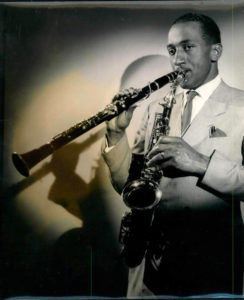
Glyn Paque. Previously unknown images of Goudie and associates in Switzerland have become available in recent years on the website Jazzindex.
Wanderlust in his blood, “Big Boy” was soon in Switzerland where he became quite popular. At first, he joined the sextet of alto saxophonist Glyn Paque (1907-1953) at the Chikito Club in Bern.
Paque’s credentials before Europe included stints with The Missourians, Jelly Roll Morton, King Oliver and Benny Carter. He spent the war years jamming away in neutral Switzerland. But Chikito management must have soured on him because in 1949 they delegated Frank to hire trumpet player Bill Coleman for a new band.
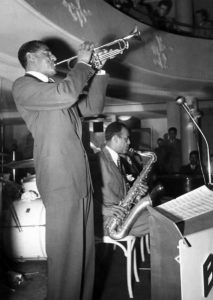
Trumpeter Merrill Stepter was working in Buck Clayton’s band when they dropped in to jam with Goudie and Coleman at the Chikito Club, 1949. Jazzindex.
Bill Coleman (b. 1904 Kentucky – d. 1981 France) mentions Goudie in his memoir, Trumpet Story, supplying details of their brief partnership — though erroneously writing that he was seven feet tall. The tale of Goudie helping launch Bill’s first performing band, their re-acquaintance and subsequent European travels are described in this audio clip.
Goudie, Chikito Club and Bill Coleman.mp3
After Chikito in 1950, Goudie and Coleman were off to Rome. Though the planned gig folded quickly they made the best of it. “Big Boy” did very well in the Italian capital. He performed with a group from Martinique and joined Coleman in a concert with the Roman New Orleans Jazz Band sponsored by the Hot Club of Rome.
Bill Coleman returned to Paris and a very successful career (and marriage) in France for the rest of his life. He wrote, “Toward the end of the Summer season, a couple of my musicians went to Germany to join Bass Hill who was playing in . . . Berlin at the Neger Bar. Eventually, Big Boy Goudie . . . stayed [there] for years.
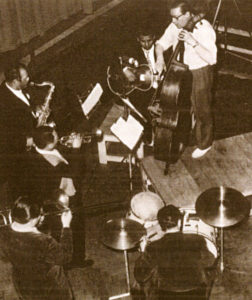
Goudie and GJC All Stars recording in Berlin for German Columbia, 1952. Horns top to bottom: Goudie, Gabriel Dores (trumpet) and Hans Wolf Schneider (trombone).
Berlin, 1950-53
Neger Bar (or Negerbar) where Goudie played 1950-53 does not translate politely into English. The German magazine Jazz Podium took club management to task on other matters:
“Clarinet veteran Frank “Big Boy” Goudie is playing with a South American trumpeter who is so wound up that I wonder why he is not playing bebop. It is amazing that Big Boy is not more stressed himself, because what the Negerbar boss, Herr Frohlich, demands of his musicians is no joke . . . making musicians – especially wonderful old gentleman like Big Boy Goudie – work from early evening until the small hours, virtually without a break.”
The trumpet player, Gabriel Dores, was originally from Brazil. The group’s (German) Columbia Records show the continuing emergence of Goudie’s personal clarinet style. Becoming his primary mode, it would serve him well in years to come. And Frank’s first vocal on disc remains his hometown’s best-known anthem, “The Saints.”
Frank “Big Boy” Goudie and the GJC All Stars, 1952-53:
The Saints
Lonesome Road
Surprisingly, the Berlin horns recorded for the Yugoslavian record label Jugoton, possibly dropping into their Zagreb studio while on tour during 1953-54. Goudie played tenor and again sang: “The Saints,” “On the Sunny Side of the Street” and “Maria Dolores.” Five of the ten sides were Latin dance music.
Song of the Wanderer
Despite working steadily in Germany for three years, Goudie’s path after the war bounced like a pinball between Paris, Switzerland, France, Berlin, Prague and back, though he was in Paris less and less often.
A Paris recording session in October 1949 brought Goudie together with reed master Sidney Bechet. But like most of their encounters the results were unremarkable and disappointing. There was more work in Latin and Caribbean music. He even visited New York City briefly in late 1954, presumably scouting out prospects for a return to the United States.
Frank Goudie left Europe for the last time on November 8, 1956, sailing from Cherbourg on HMS Queen Mary. Later that month in San Francisco, California he signed a union card with American Federation of Musicians Local 610 and settled in for his remaining years playing music by Frisco Bay.
A Big Life
Through his skill and determination Goudie repeatedly became a vanguard and exemplar far from his Louisiana origins — a Creole Johnny Appleseed of Jazz. Highly adaptable and increasingly skilled, his career came to parallel the development of Jazz itself. Always a step ahead of history, he eluded the official narratives.
Today a new entry is being written in the jazz chronicles for the previously overlooked “Big Boy.” No, he was not a radical innovator or genius who changed the course of jazz. But Goudie possessed a fierce dedication to his art and strong voice of his own on three instruments that he played on three continents.
All this was true as of late 1956. But Frank was about to undergo yet another major transformation. In his fourth and final musical life “Big Boy” was welcomed into the San Francisco jazz revival as an elder Gentleman of Jazz. Playing only clarinet, Goudie’s most personal voice emerged in an autumnal blossoming of his art.
Part three explores Goudie’s seven years in San Francisco through the recollections of those who knew him and rare exclusive tapes.
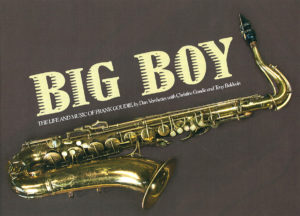
The gorgeous book BIG BOY comprehensively documents Goudie’s life, travels and music in 76 pages with 100 photos. The cover features a Conn tenor sax of the style he played known for the engraving on its bell as “The Ladyface.”
The story of “Big Boy” and early jazz continue at the JAZZ RHYTHM website: www.JAZZHOTBigstep.com.
See also: BIG BOY, The life and story of Frank Goudie, by Dan Vernhettes with Christine Goudie and Tony Baldwin (Jazzedit.org 2015). Coleman, Bill, Trumpet Story (Palgrave Macmillan/Northeastern University, 1981). Goudie’s 1960 interview by Ken Mills is available on the Music Rising website of Tulane University.
Great thanks to Richard Hadlock for interviews, corroboration, remembrance of Goudie in Rio and out-of-print San Francisco Examiner articles. Thanks also to Kenneth Gant for dramatic readings and Tony Baldwin for the Zaccarias recordings.
Great thanks to Frank’s daughter, Christine Goudie, for corroboration and photos, to Dan Vernhettes and Hal Smith for assistance. Record collectors Bo Scherman, Göran Söderwall, Rune Sjögren and Jean-François Villetard provided rare audio.
- ← Previous page
- (Page 3 of 3)

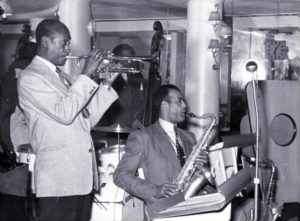
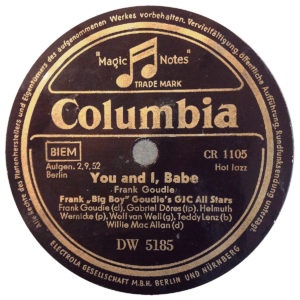
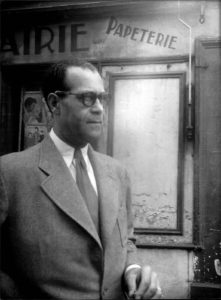
For further exploration:
Frank Goudie page:
http://www.jazzhotbigstep.com/120601.html
Bill Coleman page:
http://www.jazzhotbigstep.com/121401.html
BIG BOY Book:
http://www.jazzedit.org/English/EBb/Big-Boy.html
Frank Goudie on i-tunes:
https://itunes.apple.com/us/album/frank-big-boy-goudie-on-west-coast-vol-1-big-boys-blues/1345446943
Great series Dave. Thanks!